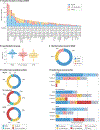Pathophysiological insights into HFpEF from studies of human cardiac tissue
- PMID: 39198624
- PMCID: PMC11750620
- DOI: 10.1038/s41569-024-01067-1
Pathophysiological insights into HFpEF from studies of human cardiac tissue
Abstract
Heart failure with preserved ejection fraction (HFpEF) is a major, worldwide health-care problem. Few therapies for HFpEF exist because the pathophysiology of this condition is poorly defined and, increasingly, postulated to be diverse. Although perturbations in other organs contribute to the clinical profile in HFpEF, altered cardiac structure, function or both are the primary causes of this heart failure syndrome. Therefore, studying myocardial tissue is fundamental to improve pathophysiological insights and therapeutic discovery in HFpEF. Most studies of myocardial changes in HFpEF have relied on cardiac tissue from animal models without (or with limited) confirmatory studies in human cardiac tissue. Animal models of HFpEF have evolved based on theoretical HFpEF aetiologies, but these models might not reflect the complex pathophysiology of human HFpEF. The focus of this Review is the pathophysiological insights gained from studies of human HFpEF myocardium. We outline the rationale for these studies, the challenges and opportunities in obtaining myocardial tissue from patients with HFpEF and relevant comparator groups, the analytical approaches, the pathophysiological insights gained to date and the remaining knowledge gaps. Our objective is to provide a roadmap for future studies of cardiac tissue from diverse cohorts of patients with HFpEF, coupling discovery biology with measures to account for pathophysiological diversity.
© 2024. Springer Nature Limited.
Conflict of interest statement
Competing interests: The authors declare no competing interests.
Figures



References
-
- Savarese G et al. Global burden of heart failure: a comprehensive and updated review of epidemiology. Cardiovasc Res 118, 3272–3287 (2022). - PubMed
-
- Borlaug BA, Sharma K, Shah SJ & Ho JE Heart failure with preserved ejection fraction: JACC scientific statement. J. Am. Coll. Cardiol 81, 1810–1834 (2023). - PubMed
-
- Dunlay SM, Roger VL & Redfield MM Epidemiology of heart failure with preserved ejection fraction. Nat. Rev. Cardiol 14, 591–602 (2017). - PubMed
-
- Redfield MM & Borlaug BA Heart failure with preserved ejection fraction: a review. JAMA 329, 827–838 (2023). - PubMed
-
- Desai AS, Lam CSP, McMurray JJV & Redfield MM How to manage heart failure with preserved ejection fraction: practical guidance for clinicians. JACC Heart Fail 11, 619–636 (2023). - PubMed
Publication types
MeSH terms
Grants and funding
LinkOut - more resources
Full Text Sources
Medical

